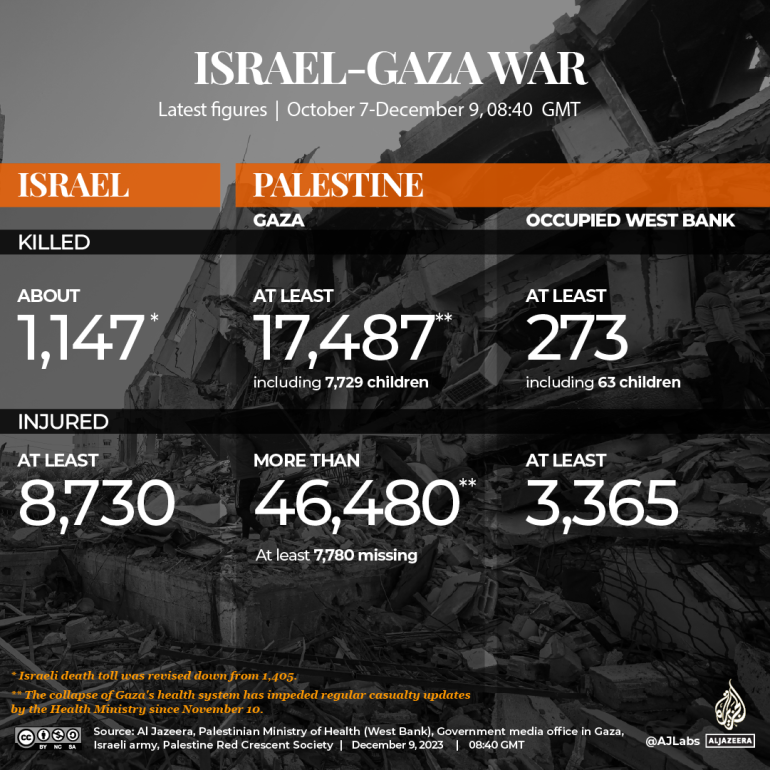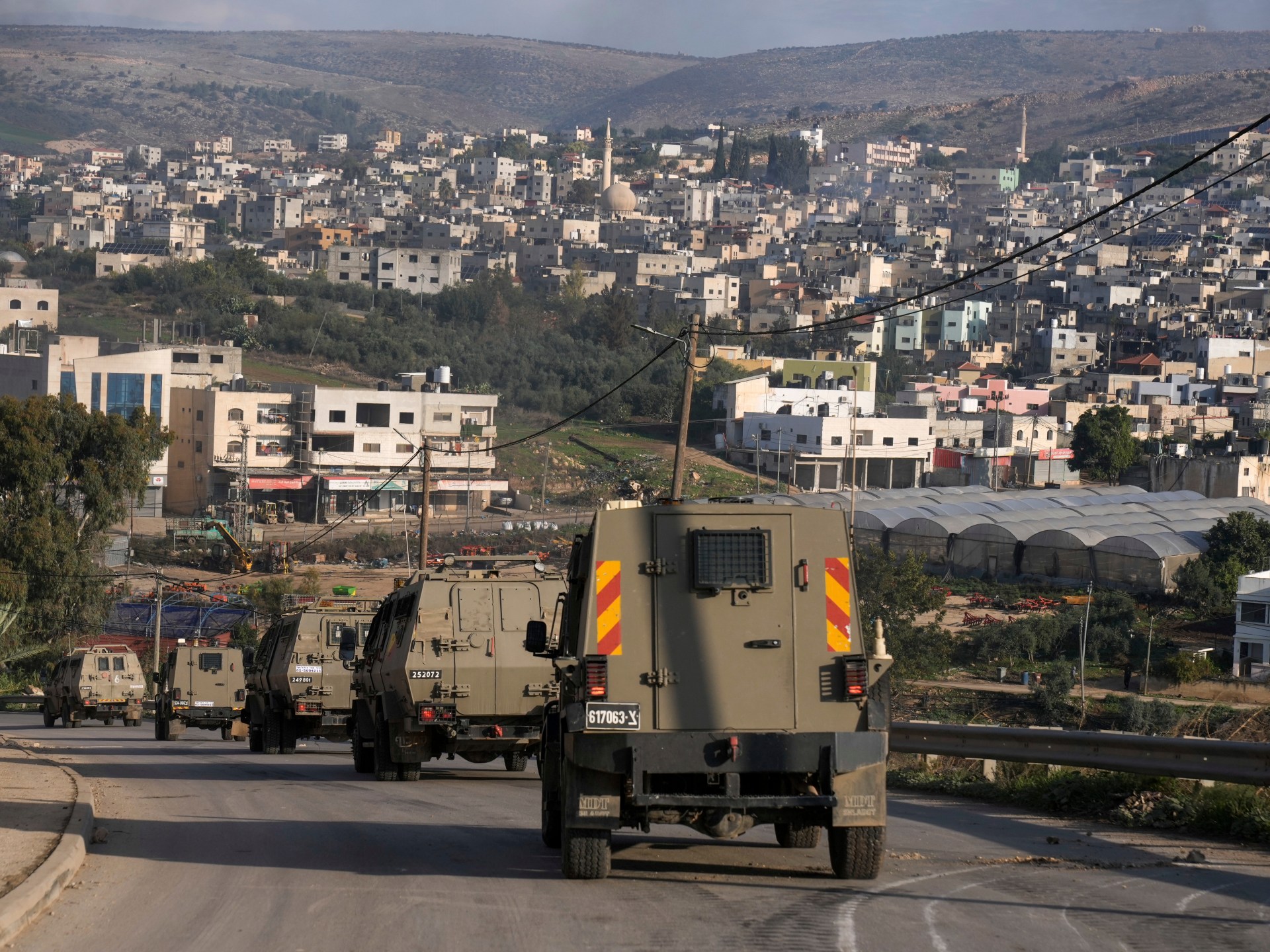The Israeli military has carried out multiple raids in the occupied West Bank as heavy fighting continued across the Gaza Strip a day after the United States used its veto power in the United Nations Security Council to block overwhelming demands for an immediate humanitarian ceasefire.
The raids that started overnight and continued into Saturday took place near Jenin, Qalqilya, Nablus, Jericho, Ramallah, Bethlehem and Hebron as at least 15 Palestinians were detained across the region, the Palestinian Prisoner’s Society told Al Jazeera.
A teenager was killed by Israeli forces in Dura, in the south of Hebron, the Palestinian Ministry of Health said.
Meanwhile, Sari Yousef Amr, a 25-year-old Palestinian, who was shot by Israeli forces earlier on Saturday subsequently died, the Palestinian news agency Wafa reported.
Amr was wounded during the raid in Dura, with Wafa citing his father as saying that Israeli forces fired live bullets into his home before detaining Amr and his brother Suhaib.
The ministry said at least 273 people, including 63 children, have been killed in the occupied West Bank since October 7, when the Israeli-Palestinian conflict broke out.
The attacks by Palestinian armed group Hamas that day prompted Israel to begin a massive air and ground offensive in Gaza that has killed close to 17,500 people. In Israel, the death toll stands at 1,147.
Al Jazeera’s Nida Ibrahim, reporting from Ramallah, said that raids have been carried out daily in several Palestinian towns and cities in the occupied West Bank.
“Israel even detains people who have been released as part of the latest [truce] deal,” she said, which saw the exchange of captives held by Hamas for Palestinian prisoners in Israeli jails. Some of the prisoners have been held and beaten before being freed again.
While Israeli forces have not rearrested any of the more than 200 Palestinians who were released as part of the temporary pause, that could soon change with the uptick in raids in the occupied West Bank, Ibrahim said.
“Palestinians say it could be a matter of minutes, that [Israeli forces] would arrest those prisoners,” she said, noting that the number of Palestinian arrests mounts every day.
A 15-year-old in Jericho was detained for 2.5 hours, beaten up and eventually released, according to our correspondent.
In the first four days of a weeklong truce between Israel and Hamas, Israel released 150 Palestinian prisoners. Over the same four days, Israel arrested at least 133 Palestinians from East Jerusalem and the West Bank, according to Palestinian prisoner associations.
More than 3,600 people have been arrested since Hamas’s October 7 infiltration and attack.
In Jenin, Israeli forces on Saturday detained four brothers of Bilal Diab – a reported member of the Palestinian Islamic Jihad group, while a minor was taken into custody from Qalqilya. At least four Palestinians were detained in Ramallah, with more detentions in Bethlehem and Hebron.
Gaza bombardment
Israeli military jets were pounding parts of north, central and south Gaza.
There were strikes on the southern city of Khan Younis, and at least five people were killed in a separate attack in Rafah – a city designated by the Israeli military as safe, the Ministry of Health in Gaza said.
Many of the 1.9 million Palestinians in Gaza who have been displaced by the war have headed south, turning Rafah near the Egyptian border into a vast camp of despair and desperation as Israel’s offensive has widened.
“In Khan Younis, there has been non-stop artillery shelling and aerial bombardment on the eastern and central sides. The Israeli military vehicles kept pushing to the centre of the city, very close to the vicinity of Nasser hospital,” said Al Jazeera’s Hani Mahmoud, reporting from Rafa.
“A home was targeted where an entire family, 13 people, were killed this morning,” he said.
Deir el-Balah in central Gaza was also targeted.
“This area was described as a safe area by the Israeli army, that’s why there are so many displaced people here. Survivors are trying to rescue those injured. The state of destruction is massive and it’s very difficult to rescue those injured. There is no equipment and everyone, including the rescue officials, is using their hands to remove the rubble,” said our colleague at Al Jazeera Arabic.
‘People haven’t eaten for days’
Vast areas of Gaza have been reduced to rubble and the UN says about 80 percent of the population has been displaced, with dire shortages of food, fuel, water and medicine reported.
Mahmoud said people in Rafah lack all the basic supplies that could help them survive.
“People here haven’t eaten for the past two days. If people do not die from the bombardment, they could die from starvation,” he said.
He added: “The situation is very desperate. It’s very cold and windy … and there is a possibility of floods if it started to rain. The tents are very small and inappropriate for people to live in.”
Meanwhile, with the death toll of medical workers in the conflict mounting, more than a dozen World Health Organization member states submitted a draft resolution on Friday that urged Israel to respect its obligations under international law to protect medical and humanitarian workers in Gaza, as well as hospitals and other medical facilities.
Only 14 of the 36 hospitals in the Gaza Strip were functioning in any capacity, according to UN humanitarian agency OCHA.

Check out our Latest News and Follow us at Facebook
Original Source

